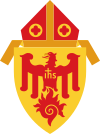Roman Catholic Archdiocese of Chicago
This article needs additional citations for verification. (April 2020) |
Archdiocese of Chicago Archidiœcesis Chicagiensis | |
|---|---|
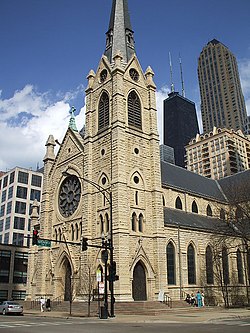 Holy Name Cathedral | |
 Coat of arms | |
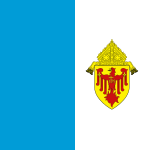 Flag | |
| Location | |
| Country | United States |
| Territory | Counties of Cook and Lake |
| Ecclesiastical province | Chicago |
| Statistics | |
| Area | 1,411 sq mi (3,650 km2) |
| Population - Total - Catholics | (as of 2017) 5.94 million 2,079,000[1] (35%) |
| Parishes | 216[1] (As of 1/2024) |
| Schools | 154 archdiocesan-run[1] 34 non-archdiocesan-run[1] |
| Information | |
| Denomination | Catholic Church |
| Sui iuris church | Latin Church |
| Rite | Roman Rite |
| Established | November 28, 1843 |
| Cathedral | Holy Name Cathedral |
| Patron saint | Immaculate Conception[citation needed] |
| Secular priests | 672[1] |
| Current leadership | |
| Pope | Francis |
| Archbishop | Blase J. Cupich[2] |
| Auxiliary Bishops | |
| Vicar General | Robert Gerald Casey[3] |
| Bishops emeritus | |
| Map | |
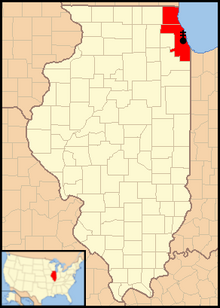 | |
| Website | |
| archchicago.org | |
The Archdiocese of Chicago (Latin: Archidiœcesis Chicagiensis) is a Latin Church ecclesiastical jurisdiction, an archdiocese of the Catholic Church located in Northeastern Illinois, in the United States. It was established as a diocese in 1843 and elevated to an archdiocese in 1880. It serves the more than 2 million Catholics in Cook and Lake counties in the state of Illinois, an area of 1,411 square miles (3,650 km2). The archdiocese is divided into six vicariates and 31 deaneries.
Blase Joseph Cupich was appointed archbishop of Chicago in 2014 (and cardinal in 2016) by Pope Francis. Cupich is assisted by six episcopal vicars, who are each responsible for a vicariate (region). The cathedral parish for the archdiocese, Holy Name Cathedral, is in the Near North Side area of the see city for the diocese, Chicago.
The Archdiocese of Chicago is the metropolitan see of the Province of Chicago. Its suffragan dioceses are the other Catholic dioceses in Illinois: Belleville, Joliet, Peoria, Rockford, and Springfield.
Joseph Cardinal Bernardin, archbishop of Chicago from 1982 to 1996, was arguably one of the most prominent figures in the American Catholic church in the post-Vatican II era, rallying progressives with his "seamless garment ethic" and his ecumenical initiatives.[4]
History
[edit]1600 to 1800
[edit]
The first Catholic presence in present-day Illinois was that of the French Jesuit missionary, Reverend Jacques Marquette, who arrived at the mouth of the Chicago River on December 4, 1674. A cabin he built for the winter became the first European settlement in the area. Marquette published his survey of the new territories and soon more French missionaries and settlers arrived.[5]
In 1696, the French Jesuit, Reverend Jacques Gravier, was named to found the Illinois mission among the Illinois, Miami, Kaskaskia and others of the Illiniwek confederacy situated in the Mississippi River and Illinois River valleys.[6]During this period, the French-Canadian and Native American Catholics in the region were under the jurisdiction of the bishop of the Diocese of Quebec in New France.
With the end of the French and Indian War in 1763, the British took control of Illinois. Their rule ended after the end of the American Revolution in 1783 when Illinois was ceded to the new United States. In 1795, the Potawatomi nation signed the Treaty of Greenville that ended the Northwest Indian War, ceding to the United States land at the mouth of the Chicago River.
1800 to 1840
[edit]
In 1804, Pope Pius VI erected the Diocese of Baltimore, covering the entire United States. In 1822, Alexander Beaubien became the first person to be baptized as a Catholic in Chicago.[7]By 1826, the Vatican had created the Diocese of St. Louis, covering Illinois and other areas of the American Midwest.
In 1833, Jesuit missionaries in Chicago wrote to Bishop Joseph Rosati of St. Louis, pleading for a priest to serve the 100 Catholics in the city. In response, Rosati appointed Reverend John Saint Cyr. a French priest, as the first resident priest in Chicago. Saint Cyr celebrated his first mass in a log cabin on Lake Street in 1833.[7] At a cost of $400, Saint Cyr constructed St. Mary, a small wooden church near Lake and State Streets. The first Catholic church in the city, it was dedicated in 1833.[8] The next year, Bishop Simon Bruté of the new Diocese of Vincennes in Indiana, visited Chicago. He found only one priest serving over 400 Catholics. Brulé asked permission from Rosati to send several priests from Vincennes to Chicago.
In 1837, Saint Cyr retired as pastor of St. Mary and was replaced by Reverend James O'Meara. He moved St. Mary to another wooden structure at Wabash Avenue and Madison Street. When O'Meara left Chicago, Saint Palais demolished the wooden church and replaced it with a brick structure.[9]
1840 to 1860
[edit]Pope Gregory XVI erected the Diocese of Chicago on November 28, 1843. It included all of the new State of Illinois, taking territory from the Dioceses of St. Louis and Vincennes.[10] In 1844, Gregory XVI named Reverend William Quarter of Ireland as the first bishop of Chicago. [7]On his arrival in Chicago, Quarter summoned a synod of the 32 priests to begin the organization of the diocese.[7]
One of Quarter's most important achievements was the passage of an Illinois law in 1845 that declared the bishop of Chicago an incorporated entity, with the power to hold real estate and other property in trust for religious purposes.[11] This would allow Quarter and future prelates to construct churches, colleges, and universities in the archdiocese. Quarter died on April 10, 1848.[12]
On October 3, 1848, Pope Pius IX appointed Reverend James Van de Velde of the Society of Jesus as the second bishop of Chicago.[13]During his brief tenure in Chicago, Van de Velde built numberous churches throughout the diocese. After the outbreak of cholera in Chicago in 1849, he established residences for the many children orphaned by the epidemic. Suffering from severe rheumatism during the harsh Chicago winters, Van De Velde persuaded the pope in 1852 to appoint him as bishop of the Diocese of Natchez in Mississippi.[14][15][16] The Vatican in 1853 erected the Diocese of Quincy, taking Southern Illinois from the Diocese of Chicago. The Diocese of Quincy later became the Diocese of Springfield in Illinois.[10]
On December 1853, Reverend Anthony O'Regan was appointed as the third bishop of Chicago by Pius IX. During his tenure, O'Regan purchased property for several churches and Calvary Cemetery. A systematic administrator and strong disciplinarian, O'Regan generated significant dissatisfaction among his clergy.[17] Many French-speaking congregants accused him of discriminating against them.[18][19] Frustrated by the opposition he faced in the diocese, he submitted his resignation in 1857 to the Vatican, which accepted in June 1858.[20]
1860 to 1900
[edit]The archdiocese lost nearly a million dollars in property damage in the Chicago fire of 1871, leading to administrative instability for decades.[11]
In 1877, the Vatican erected the Diocese of Peoria, taking counties in Central Illinois from the Diocese of Chicago. Three years later, the Vatican elevated the Diocese of Chicago to the Archdiocese of Chicago. At that time, five more counties were transferred to Peoria.[11]
1900 to 2000
[edit]In 1926, the archdiocese hosted the 28th International Eucharistic Congress.
On December 1, 1958, Our Lady of Angels School in Chicago was partially destroyed by fire. Ninety-two students and three nuns died in five classrooms on the second floor of the structure. In 1959, the National Fire Protection Association' report blamed the archdiocese for "housing their children in fire traps" such as Our Lady of the Angels. The report noted that the archdiocese continued to allow some schools to be legally-operated despite having inadequate fire safety standards.
In the early 1990s, the archdiocese closed almost 40 churches and schools.[21]
2000 to present
[edit]In 2016, increasing costs, low attendance and priest shortages fueled plans to close or consolidate up to 100 parishes and schools in the following 15 years.[22] As of 2024, 39 churches in Chicago and 21 in the surrounding suburbs had closed permanently.[23] The number of parishes in the archdiocese had been reduced from 344 to 216 as of 2024.[24]
Sexual abuse
[edit]On May 23, 2023, Illinois Attorney General Kwame Raoul released a report on the sexual abuse of children by Catholic clergy in Illinois. The investigation found that more than 450 clergy in Illinois had abused nearly 2,000 children since 1950.[25][26]
Churches
[edit]In the 1950s, Chicago-area Catholics spoke of which churches they attended and identified themselves via these churches. University of Notre Dame professor Kathleen Sprows Cummings stated that knowing one's church revealed demographic information and that it "was an identifier, almost more identifiable than the particular neighborhood that they lived in."[27]
Archbishop's residence
[edit]
The archbishop's residence at 1555 North State Parkway is a private guesthouse owned by the Archdiocese of Chicago. It served as the official residence of the archbishops of Chicago from 1885 to 2014, when incoming Archbishop Blaise Cupich decided to live in simpler quarters in the Holy Name Cathedral rectory.[28]
Listed on the National Register of Historic Places, the archbishop's residence was built by Bishop Patrick Feehan, A three-story, red brick building, it is one of the oldest structures in the Astor Street District, according to the Landmarks Preservation Council. Before its construction, the bishops of Chicago resided at a home on LaSalle Street and North Avenue. When Pope John Paul II visited Chicago in 1979, he became the first pontiff to stay at the residence. However, both Pope Pius XII and Pope Paul VI stayed there when they were cardinals.
Bishops
[edit]Since 1915, the Vatican has designated each archbishops of Chicago as a cardinal priest, with membership in the College of Cardinals. The archbishops also have responsibilities in the dicasteries of the Roman Curia. All but two prelates previously served as diocesan priests. Two prelates came from religious institutes: the Society of Jesus (Bishop Van de Velde) and the Missionary Oblates of Mary Immaculate (Archbishop George).[7]
Bishops of Chicago
[edit]- William J. Quarter (1844–1848)
- James Oliver Van de Velde (1848–1853), appointed Bishop of Natchez
- Anthony O'Regan (1854–1858)
- James Duggan (1859–1880)
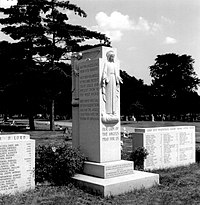
Archbishops of Chicago
[edit]- Patrick Augustine Feehan (1880–1902)
- James Edward Quigley (1903–1915)
- Cardinal George Mundelein (1915–1939)
- Cardinal Samuel Stritch (1939–1958), appointed Pro-Prefect of the Sacred Congregation for the Propagation of the Faith
- Cardinal Albert Gregory Meyer (1958–1965)
- Cardinal John Cody (1965–1982)
- Cardinal Joseph Bernardin (1982–1996)
- Cardinal Francis George (1997–2014)
- Cardinal Blase J. Cupich (2014–present)
Current auxiliary bishops
[edit]- Mark Andrew Bartosic (2018–present)
- Robert Gerald Casey (2018–present)
- Jeffrey S. Grob (2020–present)
- Robert J. Lombardo (2020–present)
Former auxiliary bishops
[edit]
- Alexander Joseph McGavick (1899–1921), appointed Bishop of La Crosse
- Peter Muldoon (1901–1908), appointed Bishop of Rockford
- Paul Peter Rhode (1908–1915), appointed Bishop of Green Bay
- Edward Francis Hoban (1922–1928), appointed Bishop of Rockford and later Bishop of Cleveland
- Bernard James Sheil (1928–1969), appointed Archbishop ad personam in 1959
- William David O'Brien (1934–1962)
- William Edward Cousins (1948–1952), appointed Bishop of Peoria and later Archbishop of Milwaukee
- Raymond Peter Hillinger (1956–1971), appointed Bishop of Rockford
- Cletus F. O'Donnell (1960–1967), appointed Bishop of Madison
- Aloysius John Wycislo (1960–1968), appointed Bishop of Green Bay
- Romeo Roy Blanchette (1965–1966), appointed Bishop of Joliet
- John L. May (1967–1969), appointed Bishop of Mobile and later Archbishop of St. Louis
- Thomas Joseph Grady (1967–1974), appointed Bishop of Orlando
- William Edward McManus (1967–1976), appointed Bishop of Fort Wayne-South Bend
- Michael Dempsey (1968–1974)
- Alfred Leo Abramowicz (1968–1995)
- Nevin William Hayes (1971–1988)
- John George Vlazny (1983-1987). appointed Bishop of Winona and later Archbishop of Portland in Oregon
- Plácido Rodriguez (1983–1994), appointed Bishop of Lubbock
- Wilton D. Gregory (1983–1994), appointed Bishop of Belleville and later Archbishop of Atlanta and Archbishop of Washington
- Timothy Joseph Lyne (1983–2013)
- John R. Gorman (1988–2003)
- Thad J. Jakubowski (1988–2003)
- Raymond E. Goedert (1991–2003)
- Gerald Frederick Kicanas (1995–2002), appointed Bishop of Tucson
- Edwin Michael Conway (1995–2004)
- George V. Murry (1995–1998), appointed Coadjutor Bishop of St. Thomas and subsequently succeeded to that see
- John R. Manz (1996–2021)
- Jerome Edward Listecki (2000–2004), appointed Bishop of La Crosse and later Archbishop of Milwaukee
- Thomas J. Paprocki (2003–2010), appointed Bishop of Springfield in Illinois
- Francis J. Kane (2003–2018)
- George J. Rassas (2006–2018)
- Alberto Rojas (2011–2019), appointed Coadjutor Bishop of San Bernardino and subsequently succeeded to that see
- Ronald Aldon Hicks (2018–2020), appointed Bishop of Joliet
- Joseph N. Perry (1998–2023)
- Andrew Peter Wypych (2011–2023)
- Kevin M. Birmingham (2020–2023)
Other priests of this diocese who became bishops
[edit]- Peter Joseph Baltes, appointed Bishop of Alton in 1869
- John McMullen, appointed Bishop of Davenport in 1881
- Maurice Francis Burke, appointed Bishop of Cheyenne in 1887
- Edward Joseph Dunne, appointed Bishop of Dallas in 1893
- Thaddeus Joseph Butler, appointed Bishop of Concordia in 1897 (died before consecration)
- Edmund Michael Dunne, appointed Bishop of Peoria in 1909
- Stanislaus Vincent Bona, appointed Bishop of Grand Island in 1931
- Moses Elias Kiley, appointed Bishop of Trenton in 1934
- Francis Joseph Magner, appointed Bishop of Marquette in 1940
- Patrick Thomas Brennan,(priest here, 1928–1936), appointed Prefect of Kwoszu, Korea (South) in 1948
- Martin Dewey McNamara, appointed Bishop of Joliet in Illinois in 1948
- William Aloysius O'Connor, appointed Bishop of Springfield in Illinois in 1948
- Donald Martin Carroll, appointed Bishop of Rockford in 1956 (did not take effect)
- Ernest John Primeau, appointed Bishop of Manchester in 1959
- Romeo Roy Blanchette, appointed Auxiliary Bishop of Joliet in Illinois in 1965
- Raymond James Vonesh, appointed Auxiliary Bishop of Joliet in Illinois in 1968
- Paul Casimir Marcinkus, appointed titular Archbishop in 1968
- Thomas Joseph Murphy, appointed Bishop of Great Falls in 1978
- John Richard Keating, appointed Bishop of Arlington in 1983
- James Patrick Keleher, appointed Bishop of Belleville in 1984
- Edward Michael Egan, appointed Auxiliary Bishop of New York in 1985; future Cardinal
- Edward James Slattery, appointed Bishop of Tulsa in 1993
- Edward Kenneth Braxton, appointed Auxiliary Bishop of St. Louis in 1995
- Robert Emmet Barron, appointed Auxiliary Bishop of Los Angeles in 2015; appointed bishop of Winona-Rochester in 2022
- Michael G. McGovern, appointed Bishop of Belleville in 2020
- Louis Tylka, appointed Coadjutor Bishop of Peoria in 2020 and subsequently succeeded to that see
Structure of the archdiocese
[edit]
Administration
The archdiocese pastoral centers are Archbishop Quigley Center, 835 North Rush Street and Cardinal Meyer Center, 3525 South Lake Park Avenue, both in Chicago.
Departments
[edit]As of 2024, the archdiocese has the following departments, agencies and offices:
- Amate House
- Archdiocesan Council of Catholic Women
- Archives and Records
- Assistance Ministry
- Catechesis and Youth Ministry
- Catholic Cemeteries
- Catholic Charities
- Chicago Airports Catholic Chaplaincy
- Catholic Schools
- Chancellor's Office
- Communications and Public Relations
- Conciliation
- Diaconate
- Divine Worship
- Ecumenical and Interreligious Affairs
- Family Ministries
- Financial Services
- Lay Ecclesial Ministry
- Legal Services
- Liturgy Training Publications
- Metropolitan Tribunal
- Ecumenical and Interreligious Affairs
- Evangelization and Missionary Discipleship
- Information Technology
- Human Dignity and Solidarity
- Persons with Disabilities
- Parish Vitality and Mission
- Protection of Children and Youth
- Planning and Construction
- Respect Life
- Stewardship and Development
- Vocations
- Young Adult Ministry
- Youth Ministry[29]
Office of Catholic Schools
[edit]
The Office of Catholic Schools operates, manages, and supports diocesan and Catholic primary and secondary schools. Catholic education in the Chicago area began on June 3, 1844, with the opening of a boys' school. During the 19th and early 20th centuries, the archdiocese established schools serving Germans, Poles, Czechs and Bohemians, French, Slovaks, Lithuanians, Puerto Rican Americans, African Americans, Italians, and Mexicans. Many of these schools were founded and run by religious sisters.
The school construction boom in the archdiocese ended when Cardinal John Cody decided to limit construction of schools in Lake County and suburban Cook County. Due to demographic changes, the archdiocese closed over half of its urban schools between 1966 and 2005.[30]
Between 1984 and 2004, the archdiocese closed 148 schools and 10 school sites.[31] An August 27, 2015, article in the Chicago Tribune refers to the Office of Catholic Schools as the largest private school system in the United States.[32] At the outset of the 2020/21 academic year, the archdiocese ran 160 elementary schools and three high schools. An additional eight Catholic elementary schools and 28 Catholic high schools that are not archdiocesan-run are located within the archdiocese.[1] As of 2015[update], the superintendent of Catholic Schools is Jim Rigg.[33]
In January 2018, the archdiocese announced the closure of five of its schools.[34] In January 2020, the archdiocese announced the closure of five morer schools.[35] As of 2022, there are 33 Catholic high schools currently operating in Cook and Lake counties, seven all-girl high schools, seven all-boys high schools and 19 co-ed high schools.[36]
Respect Life Office
[edit]Cardinal Francis George established the Respect Life Office in the archdiocese. It provides educational resources and a speakers bureau, and sponsors conferences, retreats and rallies. The Office runs Project Rachel Post Abortion Healing, a program for women who have abortion procedures; and the Chastity Education Initiative, which advises youth and young adults on sexuality issues.[37][38]
The office has coordinated the local 40 Days for Life campaign and trips to the March for Life rallies in both Chicago and Washington, DC, for college and high school students.[39][40]
Seminary
[edit]- University of Saint Mary of the Lake (Mundelein Seminary) – major seminary
Province of Chicago
[edit]
- Diocese of Belleville
- Diocese of Joliet in Illinois
- Diocese of Peoria
- Diocese of Rockford
- Diocese of Springfield in Illinois
See also
[edit]- Category:Roman Catholic Archdiocese of Chicago
- The Catholic New World, the official newspaper of the Archdiocese
- Our Lady of Perpetual Help (Glenview, Illinois), one of the largest parishes in the Archdiocese
- Polish Cathedral style churches of Chicago
- St. Anne Catholic Community, another of the largest parishes in the Archdiocese
- Ukrainian Catholic Eparchy of Chicago
- Syro-Malabar Catholic Diocese of Saint Thomas the Apostle of Chicago
- List of the Roman Catholic bishops of the United States
- List of the Roman Catholic cathedrals of the United States
- List of the Roman Catholic dioceses of the United States
- United States Conference of Catholic Bishops
- Sexual abuse scandal in the Catholic archdiocese of Chicago
- Shrine of Christ the King, Sovereign Priest; in Chicago, Illinois[41]
References
[edit]- ^ a b c d e f "Facts and Figures - Archdiocese of Chicago". www.archchicago.org.
- ^ Joshua J. McElwee (September 21, 2014). "Exclusive: Chicago's new archbishop talks about 'stepping into the unknown'". National Catholic Reporter. Retrieved September 22, 2014.
- ^ "Cardinal Blase J. Cupich Names Bishop Robert G. Casey New Vicar General of Archdiocese of Chicago" (Press release). Archdiocese of Chicago. August 28, 2020. Retrieved September 3, 2020.
- ^ "A Consistent Ethic of Life: Continuing the Dialogue". www.priestsforlife.org. Retrieved May 15, 2017.
- ^ Monet, J. (1979). "Marquette, Jacques". Dictionary of Canadian Biography. University of Toronto/Laval University. Retrieved March 3, 2016.
- ^ "Jacques Gravier", Dictionary of Canadian Biography Online, accessed 1 Mar 2010
- ^ a b c d e Melody, John (1908). "Archdiocese of Chicago". Catholic Encyclopedia. Vol. 3. New York: Robert Appleton Company. Retrieved March 3, 2016.
- ^ "History - Old St. Mary's Chicago". oldstmarys.com. July 24, 2017. Retrieved November 15, 2024.
- ^ "Father O'Meara biography". St. Dennis Church. Archived from the original on March 10, 2007. Retrieved April 29, 2006.
- ^ a b "Chicago (Archdiocese) [Catholic-Hierarchy]". www.catholic-hierarchy.org. Retrieved November 15, 2024.
- ^ a b c Avella, Steven M. (2005). "Roman Catholic Archdiocese of Chicago". Encyclopedia of Chicago. Chicago Historical Society/Newberry Library. Retrieved March 3, 2016.
- ^ "Bishop William Quarter (1806–1848)". Offaly Historical & Archaeological Society. September 2, 2007. Archived from the original on January 5, 2006. Retrieved March 3, 2016.
- ^ "Bishop James Oliver Van de Velde [Catholic-Hierarchy]". www.catholic-hierarchy.org. Retrieved November 17, 2024.
- ^ De Smet, Pierre-Jean. Death of Bishop Van de Velde Archived 2012-10-20 at the Wayback Machine, 1855 eulogy to Belgian newsletter by fellow Belgian-born Jesuit; accessed April 12, 2009.
- ^ Biographical Sketch of Bishop James O. Van de Velde, S. J. Archived 2011-07-28 at the Wayback Machine, St. Mary Basilica Archives. Accessed April 13, 2009.
- ^ Archdiocese of Chicago: (Chicagiensis), New Advent Catholic Encyclopedia. Accessed April 15, 2009.
- ^ Garraghan, Gilbert Joseph. The Catholic Church in Chicago, 1673–1871.
- ^ Clarke, Richard Henry. Lives of the deceased bishops of the Catholic Church in the United States.
- ^ "Founding Fathers". Hidden Truths: Catholic Cemetery.
- ^ "Meet the previous leaders of the church in Chicago", Chicago Catholic, 27 November 2016
- ^ Marx, Gary (January 29, 1990). "CHURCHES MAY SHUT, COMMUNITY DOESN'T". Chicago Tribune.
- ^ "Archdiocese May Close Nearly 100 Churches in Next 15 Years". Curbed Chicago. February 9, 2016.
- ^ "Decrees and Letters - Church Relegations". Archdiocese of Chicago. Retrieved July 3, 2024.
- ^ Ahern, Mary Ann (February 8, 2022). "Major Overhaul Will Leave Chicago Archdiocese With 123 Fewer Parishes By July". NBC 5 Chicago.
- ^ "Report On Catholic Clergy Child Sex Abuse In Illinois 2023". Office of the Attorney General - State of Illinois. May 23, 2023. Retrieved February 20, 2024.
- ^ Foody, Kathleen; Tarm, Michael (May 23, 2023). "Catholic clergy sexually abused Illinois kids far more often than church acknowledged, state finds". AP News. Retrieved February 20, 2024.
- ^ "Angels Too Soon: The Tragedy of the 1958 Our Lady of the Angels School Fire". WTTW. Retrieved April 3, 2024.
- ^ "Archbishop Residence Chicago | Chicago Gold Coast Walking Tour | eVisitorGuide". www.evisitorguide.com. Retrieved November 15, 2024.
- ^ "Departments and Agencies" (shtm). Archdiocese of Chicago. Retrieved April 29, 2006.
- ^ Skerrett, Ellen (2005). "Catholic School System". Chicago Historical Society/Newberry Library. Retrieved March 3, 2016.
- ^ Simons, Paul. "Closed School History: 1984–2004" (PDF). Archdiocese of Chicago. Retrieved March 3, 2016.
- ^ Crosby, Rachel (August 27, 2015). "Chicago Catholic Schools names new superintendent". Chicago Tribune. Chicago. Retrieved November 24, 2023.
- ^ Crosby, Rachel (August 27, 2000). "Chicago Catholic Schools names new superintendent". Chicago Tribune. Retrieved March 3, 2016.
- ^ Hope, Leah; Elgas, Rob; Hickey, Megan (January 19, 2018). "Archdiocese of Chicago to close 5 Catholic schools". ABC7 Chicago.
- ^ "Catholic Archdiocese of Chicago to Close 5 Schools". NBC Chicago. January 13, 2020. Retrieved October 19, 2020.
- ^ "Six decades later, officials say Regina Dominican's all-girls education increasingly relevant". Chicago Tribune. March 26, 2019. Retrieved May 23, 2022.
- ^ "Respect Life Office". Archdiocese of Chicago. Retrieved March 3, 2016.
- ^ "Chastity Education Initiative | Respect Life and Chastity Education - Parish Vitality and Mission". pvm.archchicago.org. Retrieved November 17, 2024.
- ^ ""March for Life Chicago" to Mark Respect Life Month Activities" (Press release). Archdiocese of Chicago. January 16, 2014.
- ^ DeFiglio, Pam (October 12, 2008). "Crowd kicks off '40 Days for Life' prayer vigil". Catholic New World. Retrieved March 3, 2016.
- ^ "Information, Schedule & Directions". Shrine of Christ the King. Retrieved March 3, 2016.
Further reading
[edit]- Coughlin, Roger J. Charitable Care in the Archdiocese of Chicago (Chicago: The Catholic Charities, 2009)
- Dahm, Charles W. Power and Authority in the Catholic Church: Cardinal Cody in Chicago (University of Notre Dame Press, 1981)
- Faraone, Dominic E. "Urban Rifts and Religious Reciprocity: Chicago and the Catholic Church, 1965–1996." (2013, PhD, Marquette University); Bibliography pages 359–86. online
- Garrathan, Gilbert J. The Catholic Church in Chicago, 1673–1871 (Loyola University Press, 1921)
- Greeley, Andrew M. Chicago Catholics and the struggles within their Church (Transaction Publishers, 2011)
- Hoy, Suellen. Good Hearts: Catholic Sisters in Chicago's Past (University of Illinois Press, 2006)
- Kantowicz, Edward R. Corporation Sole: Cardinal Mundelein and Chicago Catholicism (University of Notre Dame Press, 1983)
- Kantowicz, Edward R. The Archdiocese of Chicago: A Journey of Faith (Ireland: Booklink, 2006)
- Kelliher, Thomas G. Hispanic Catholics and the Archidiocese of Chicago, 1923–1970 (PhD Diss. UMI, Dissertation Services, 1998)
- Kennedy, Eugene. This Man Bernardin (Loyola U. Press, 1996)
- Koenig, Rev. Msgr. Harry C., S.T.D., ed. Caritas Christi Urget Nos: A History of the Offices, Agencies, and Institutions of the Archdiocese of Chicago (2 vols. Catholic Bishop of Chicago, 1981)
- Koenig, Rev. Msgr. Harry C., S.T.D., ed. A History of the Parishes of the Archdiocese of Chicago. (2 vols. Catholic Bishop of Chicago, 1980)
- McMahon, Eileen M. What Parish Are You From?: A Chicago Irish Community and Race Relations (University Press of Kentucky, 1995)
- Neary, Timothy B. "Black-Belt Catholic Space: African-American Parishes in Interwar Chicago." US Catholic Historian (2000): 76–91. in JSTOR
- Parot, Joseph John. Polish Catholics in Chicago: 1850–1920: a Religious History (Northern Illinois University Press, 1981.)
- Reiff, Janice L. et al., eds. The Encyclopedia of Chicago (University of Chicago Press, 2004) online
- Sanders, James W. The education of an urban minority: Catholics in Chicago, 1833–1965 (Oxford University Press, 1977)
- Shanabruch, Charles. Chicago's Catholics: The evolution of an American identity (Univ of Notre Dame Press, 1981)
- Skerrett, Ellen. "The Catholic Dimension." in Lawrence J. McCaffrey et al. eds. The Irish in Chicago (University of Illinois Press, 1987)
- Skerrett, Ellen. Chicago's Neighborhoods and the Eclipse of Sacred Space (University of Notre Dame Press, 1994)
- Skerrett, Ellen. et al. eds., Catholicism, Chicago Style (Loyola University Press, 1993)
- Skok, Deborah A. More Than Neighbors: Catholic Settlements and Day Nurseries in Chicago, 1893–1930 (Northern Illinois University Press, 2007)
- Wall, A.E.P. The Spirit of Cardinal Bernardin (Chicago: Thomas More Press, 1983)


